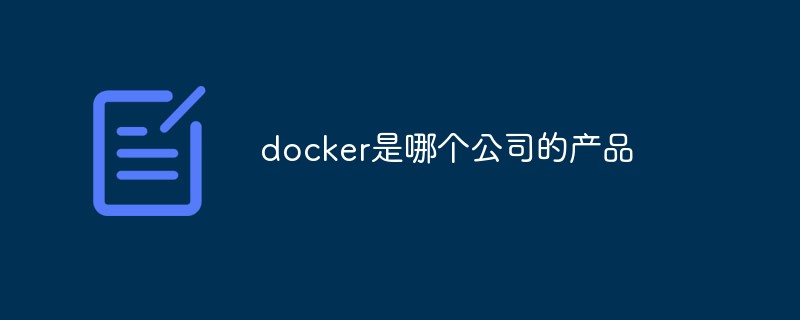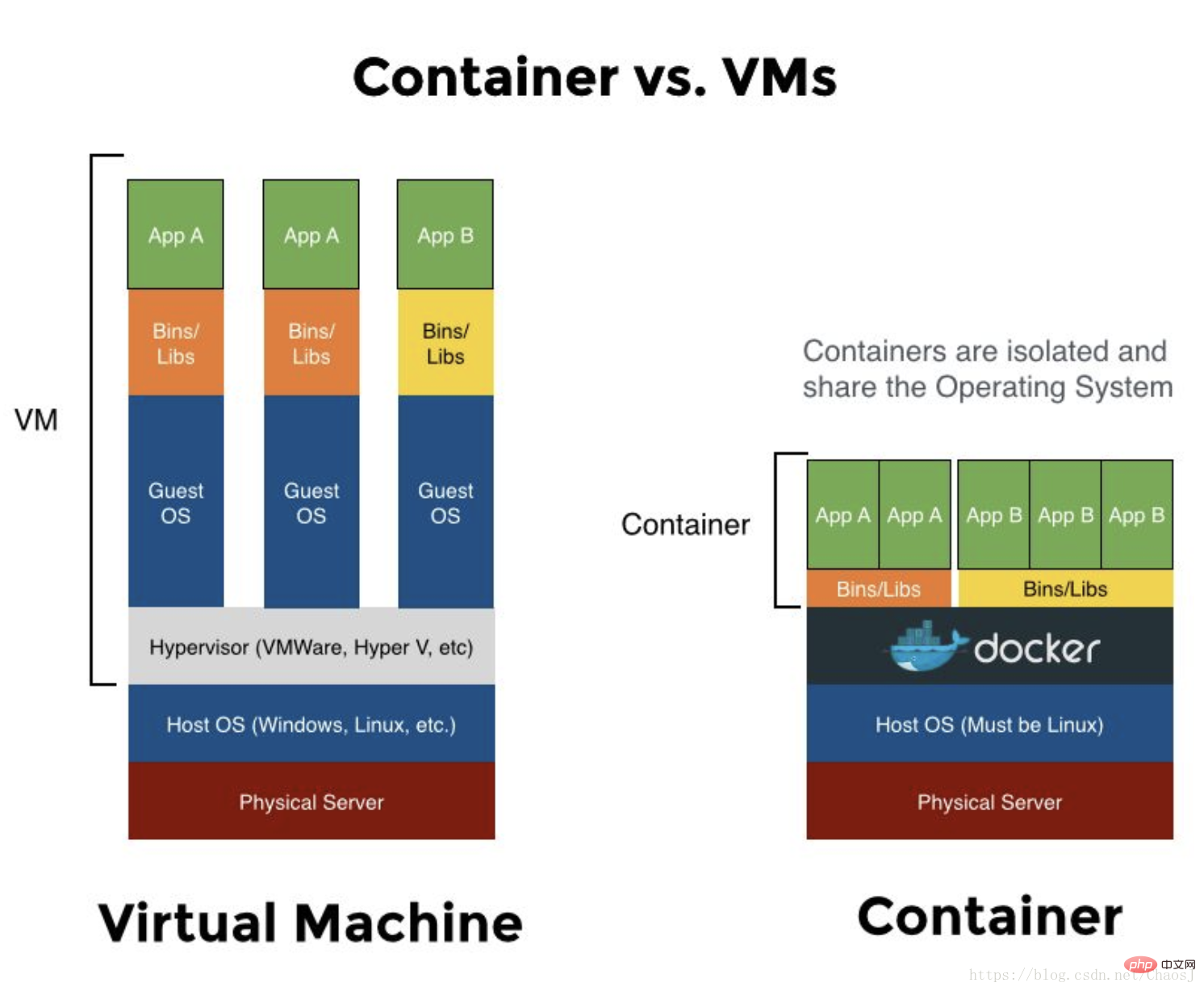Which company's product is docker?
Docker is a product of dotCloud; docker was originally an internal project launched by dotCloud founder "Solomon Hykes" while he was in France. It is an innovation based on dotCloud's many years of cloud service technology and was launched in 2013. In March of this year, it was open sourced under the "Apache 2.0" licensing agreement, and the main project code is maintained on GitHub.

The operating environment of this tutorial: linux7.3 system, docker version 19.03, Dell G3 computer.
Which company's product is docker
What is docker
Docker was originally an internal company launched by dotCloud founder Solomon Hykes while he was in France. The project is an innovation based on dotCloud's cloud service technology for many years. It was open sourced under the Apache 2.0 licensing agreement in March 2013. The main project code is maintained on GitHub. The Docker project later joined the Linux Foundation and established the Open Container Alliance (OCI) to promote it.
Docker has received widespread attention and discussion since it was open source. So far, its GitHub project has exceeded 46,000 stars and more than 10,000 forks. Even due to the popularity of the Docker project, at the end of 2013, dotCloud decided to change its name to Docker. Docker was originally developed and implemented on Ubuntu 12.04; Red Hat has supported Docker since RHEL 6.5; Google has also widely used Docker in its PaaS products.
Docker is developed and implemented using the Go language launched by Google. It is based on the Linux kernel's cgroup, namespace, and AUFS-like Union FS and other technologies to encapsulate and isolate the process. It is a virtualization technology at the operating system level. Because the isolated process is independent of the host and other isolated processes, it is also called a container. The initial implementation was based on LXC. Starting from version 0.7, LXC was removed and the self-developed libcontainer was used instead. Starting from 1.11, it further evolved to use runC and containerd.
Based on the container, Docker has further encapsulated everything from file systems, network interconnection to process isolation, etc., which greatly simplifies the creation and maintenance of containers. Docker technology is lighter and faster than virtual machine technology.
The picture below compares the differences between Docker and traditional virtualization methods. Traditional virtual machine technology is to virtualize a set of hardware, run a complete operating system on it, and then run the required application processes on the system; while the application processes in the container run directly in the host's kernel, and the container does not have its own kernel, and there is no hardware virtualization. Therefore, containers are lighter than traditional virtual machines.

As can be seen from the above figure:
- The docker container is an application layer abstraction used to package code and dependent resources together. Multiple containers can run on the same machine, sharing the operating system kernel, but each running as an independent process in user space. Compared with virtual machines, containers occupy less space (the container image size is usually only a few dozen megabytes) and can be started in an instant.
- Virtual machine (VM) is a physical hardware layer abstraction that is used to combine a One server becomes multiple servers. The hypervisor allows multiple VMs to run on a single machine. Each VM contains an entire operating system, one or more applications, necessary binaries and library resources, and therefore takes up a lot of space. And the VM startup is also very slow
Take the title picture of the docker official website as the end of this part, as a summary: Build, Manage and Secure Your Apps Anywhere. Your Way.

Recommended learning: "docker video tutorial"
The above is the detailed content of Which company's product is docker?. For more information, please follow other related articles on the PHP Chinese website!

Hot AI Tools

Undresser.AI Undress
AI-powered app for creating realistic nude photos

AI Clothes Remover
Online AI tool for removing clothes from photos.

Undress AI Tool
Undress images for free

Clothoff.io
AI clothes remover

AI Hentai Generator
Generate AI Hentai for free.

Hot Article

Hot Tools

Notepad++7.3.1
Easy-to-use and free code editor

SublimeText3 Chinese version
Chinese version, very easy to use

Zend Studio 13.0.1
Powerful PHP integrated development environment

Dreamweaver CS6
Visual web development tools

SublimeText3 Mac version
God-level code editing software (SublimeText3)

Hot Topics
 How to package project with pycharm
Apr 25, 2024 am 03:54 AM
How to package project with pycharm
Apr 25, 2024 am 03:54 AM
There are four ways to package a project in PyCharm: Package as a separate executable file: Export to EXE single file format. Packaged as an installer: Generate Setuptools Makefile and build. Package as a Docker image: specify an image name, adjust build options, and build. Package as a container: Specify the image to build, adjust runtime options, and start the container.
 Docker completes local deployment of LLama3 open source large model in three minutes
Apr 26, 2024 am 10:19 AM
Docker completes local deployment of LLama3 open source large model in three minutes
Apr 26, 2024 am 10:19 AM
Overview LLaMA-3 (LargeLanguageModelMetaAI3) is a large-scale open source generative artificial intelligence model developed by Meta Company. It has no major changes in model structure compared with the previous generation LLaMA-2. The LLaMA-3 model is divided into different scale versions, including small, medium and large, to suit different application needs and computing resources. The parameter size of small models is 8B, the parameter size of medium models is 70B, and the parameter size of large models reaches 400B. However, during training, the goal is to achieve multi-modal and multi-language functionality, and the results are expected to be comparable to GPT4/GPT4V. Install OllamaOllama is an open source large language model (LL
 Pi Node Teaching: What is a Pi Node? How to install and set up Pi Node?
Mar 05, 2025 pm 05:57 PM
Pi Node Teaching: What is a Pi Node? How to install and set up Pi Node?
Mar 05, 2025 pm 05:57 PM
Detailed explanation and installation guide for PiNetwork nodes This article will introduce the PiNetwork ecosystem in detail - Pi nodes, a key role in the PiNetwork ecosystem, and provide complete steps for installation and configuration. After the launch of the PiNetwork blockchain test network, Pi nodes have become an important part of many pioneers actively participating in the testing, preparing for the upcoming main network release. If you don’t know PiNetwork yet, please refer to what is Picoin? What is the price for listing? Pi usage, mining and security analysis. What is PiNetwork? The PiNetwork project started in 2019 and owns its exclusive cryptocurrency Pi Coin. The project aims to create a one that everyone can participate
 Agile development and operation of PHP microservice containerization
May 08, 2024 pm 02:21 PM
Agile development and operation of PHP microservice containerization
May 08, 2024 pm 02:21 PM
Answer: PHP microservices are deployed with HelmCharts for agile development and containerized with DockerContainer for isolation and scalability. Detailed description: Use HelmCharts to automatically deploy PHP microservices to achieve agile development. Docker images allow for rapid iteration and version control of microservices. The DockerContainer standard isolates microservices, and Kubernetes manages the availability and scalability of the containers. Use Prometheus and Grafana to monitor microservice performance and health, and create alarms and automatic repair mechanisms.
 PHP distributed system architecture and practice
May 04, 2024 am 10:33 AM
PHP distributed system architecture and practice
May 04, 2024 am 10:33 AM
PHP distributed system architecture achieves scalability, performance, and fault tolerance by distributing different components across network-connected machines. The architecture includes application servers, message queues, databases, caches, and load balancers. The steps for migrating PHP applications to a distributed architecture include: Identifying service boundaries Selecting a message queue system Adopting a microservices framework Deployment to container management Service discovery
 How to install deepseek
Feb 19, 2025 pm 05:48 PM
How to install deepseek
Feb 19, 2025 pm 05:48 PM
There are many ways to install DeepSeek, including: compile from source (for experienced developers) using precompiled packages (for Windows users) using Docker containers (for most convenient, no need to worry about compatibility) No matter which method you choose, Please read the official documents carefully and prepare them fully to avoid unnecessary trouble.
 How to optimize the performance of Java functions through containerization?
Apr 29, 2024 pm 03:09 PM
How to optimize the performance of Java functions through containerization?
Apr 29, 2024 pm 03:09 PM
Containerization improves Java function performance in the following ways: Resource isolation - ensuring an isolated computing environment and avoiding resource contention. Lightweight - takes up less system resources and improves runtime performance. Fast startup - reduces function execution delays. Consistency - Decouple applications and infrastructure to ensure consistent behavior across environments.
 Deploy JavaEE applications using Docker Containers
Jun 05, 2024 pm 08:29 PM
Deploy JavaEE applications using Docker Containers
Jun 05, 2024 pm 08:29 PM
Deploy Java EE applications using Docker containers: Create a Dockerfile to define the image, build the image, run the container and map the port, and then access the application in the browser. Sample JavaEE application: REST API interacts with database, accessible on localhost after deployment via Docker.






